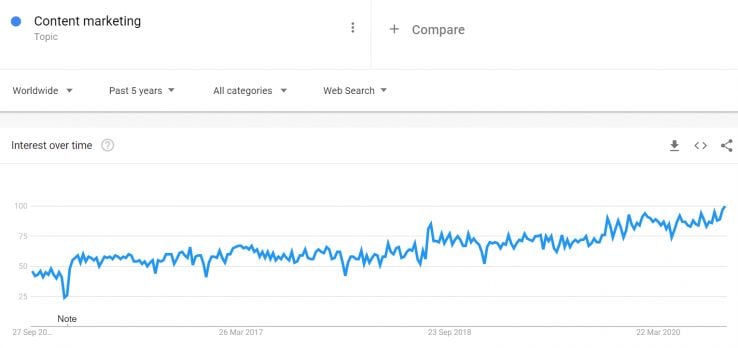Content, content, and more content! That’s what SEO is all about nowadays, right? Compared to when I started working in SEO (2014), today, content is consistently one of the most popular topics covered at digital marketing conferences, there are way more tools that focus on content analysis and optimization, and overall it seems to dominate most of SEO news.
Don’t believe me? Here’s a nice Google Trends graph that may change your mind:
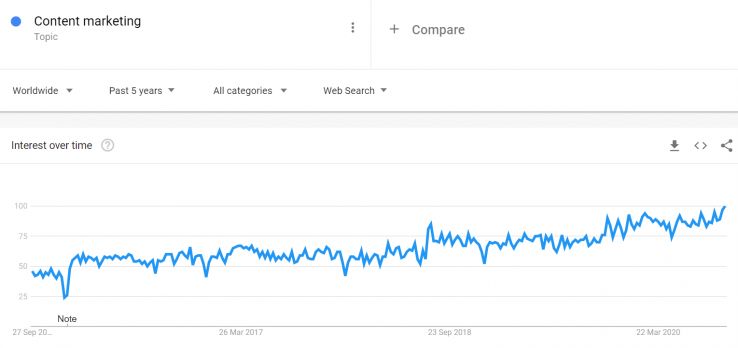
Google Trends screenshot for “content marketing” as a topic, set for worldwide interest.
But why is it that content is now dominating the SEO scene? How vital is content for your SEO strategy, actually? And most importantly: how can you be content with your site’s content? Puns aside, this post aims to help you figure out potential causes of your underperforming content and how to improve it.
Why content is key in SEO in 2020
Content is one of the most important factors in SEO. Just by paying close attention to what Google has been communicating to webmasters in the last few years, it’s clear that they’ve put a strong emphasis on “content” as a decisive ranking factor.
For instance, let’s have a look at this post, from August 2019, which talks about Google’s regular updates and what webmasters should focus on:
“Focus on content: pages that drop after a core update don’t have anything wrong to fix. We suggest focusing on ensuring you’re offering the best content you can. That’s what our algorithms seek to reward.”
The article goes on, listing a series of questions that may help webmasters when self-assessing their own content (I strongly recommend reading the entire post).
That said, content alone cannot and should not be enough for a website to rank well, but it is a pretty great starting point!
Underperforming content: theory first
What is underperforming content?
When I say “underperforming content”, I’m referring to content, either on transactional/commercial pages or editorial ones, that does not perform up to its potential. This could be content that either used to attract a good level of organic traffic and now doesn’t, or content that never did generate any organic traffic despite the efforts you might have put in.
Over 90% of content gets no traffic from Google. Ninety bloody percent! This means that nine pages out of 10 are likely not to receive any organic traffic at all — food for thought.
What are the causes of underperforming content?
There could be many reasons why your content is not doing well, but the brutal truth is often simple: in most cases, your content is simply not good enough and does not deserve to rank in the top organic positions.
Having said that, here are the most common reasons why your content may be underperforming: they are in no particular order and I will highlight the most important, in my opinion.
Your content does not match the user intent
Based on my experience, this is a very important thing that even experienced marketers still get wrong. It may be the case that your content is good and relevant to your users, but does not match the intent that Google is showcasing in the SERP for the keywords of focus.
As SEOs, our aim should be to match user intent, which means we first need to understand the what and the who before defining the how. Whose intent we are targeting and what is represented in the SERP will define the strategy we use to get there.
Example: webmasters who hope to rank for a “navigational or informational” keyword with a transactional, page or vice versa.
Your content isn’t in the ideal format Google is prioritizing
Google may be favoring a certain type of format which your content doesn’t conform to, hence it isn’t receiving the expected visibility.
Example: you hope to rank with a text-heavy blog post for a “how to” keyword where Google is prioritizing video content.
Your content is way too “thin” compared to what is ranking
It doesn’t necessarily have to be a matter of content length (there is no proven content length formula out there, trust me) but more relevance and comprehensiveness. It may be the case that your content is simply not as compelling as other sites out there, hence Google prioritizing those over you.
Example: you hope to rank for heavily competitive informational keywords with a 200-words blog post.
Your content isn’t as up-to-date
If your content is very topical, and such a topic heavily depends on information which may change with time, then Google will reward sites that put effort into keeping the content fresh and up-to-date. Apart from search engines themselves, users really care about fresh content — no one wants to read an “SEO guide to improve underperforming content” that was created in 2015!
Example: certain subjects/verticals tend to be more prone to this issue, but generally anything related to regulations/laws/guidelines which tend to change often.
Your content is heavily seasonal or tied to a past event/experience
Self-explanatory: if your content is about something that occurred in the past, generally the interest for that particular subject will gradually decrease over time. There are exceptions, of course (god save the 90s and my fav Netflix show “The Last Dance”), but you get the gist.
Example: topics such as dated events or experiences (Olympics 2016, past editions of Black Friday, and so on) or newsworthy content (2016 US election, Kanye running for president — no wait that is still happening…).
Your tech directives have changed the page’s indexation status
If something happens to your page that makes it fall out of Google’s index. The most common issues could be: unexpected no-index tag, canonical tag, incorrect hreflang tags, page status changes, page removed with Google Search Console’s remove tool, and so on.
Example: after some SEO recommendations, your devs mistakenly put a no-index tag on your page without you realizing.
Your page is victim of duplication or cannibalization
If you happen to cover the same or similar keyword topic with multiple pages, this may trigger duplication and/or cannibalization, which ultimately will result in a loss of organic visibility.
Example: you launch a new service page alongside your current offerings, but the on-page focus (metadata, content, linking structure) isn’t different or unique enough and it ends up cannibalizing your existing visibility.
Your page has been subject to JavaScript changes that make the content hard to index for Google
Let’s not go into a JavaScript (JS) rabbit hole and keep it simple: if some JS stuff is happening on your page and it’s dynamically changing some on-page SEO elements, this may impact how Google indexes your content.
Example: fictitious case where your site goes through a redesign, heavy JS is now happening on your browser and changing a key part of your content that now Google cannot render easily — that is a problem!
Your page has lost visibility following drastic SERP changes
The SERP has changed extensively in the last few years, which means many more new features that are now present weren’t there before. This may cause disruption to previous rankings (hence to your previous CTR), or make your pages fall out of Google’s precious page one.
Also, don’t forget to consider that the competition might have gotten stronger with time, so that could be another reason why you lose significant visibility.
Example: some verticals have been impacted more than others (jobs, flights, and hotels, for instance) where Google’s own snippets and tools are now getting the top of the SERP. If you are as obsessed with SERP chances, and in particular PAA, as I am and want more details, have a read here.
Your content doesn’t have any backlinks
Without going into too much detail on this point — it could be a separate blog post — for very competitive commercial terms, not having any/too few backlinks (and what backlinks represent for your site in Google’s eyes) can hold you back, even if your page content is compelling on its own. This is particularly true for new websites operating in a competitive environment.
Example: for a challenging vertical like fashion, for instance, it is extremely difficult to rank for key head terms without a good amount of quality (and naturally gained) backlinks to support your transactional pages.
How to find the issues affecting your content
We’ve covered the why above, let’s now address the how: how to determine what issue affects your page/content. This part is especially dedicated to a not-too savvy SEO audience (skip this part and go straight to next if you are after the how-to recommendations).
I’ll go through a list of checks that can help you detect the issues listed above.
Technical checks
Google Search Console
Use the URL inspection tool to analyze the status of the page: it can help you answer questions such as:
- Has my page been crawled? Are we even allowing Google to crawl the page?
- Has my page been indexed? Are we even allowing Google to index the page?
By assessing the Coverage feature, Google will share information about the crawlability and indexability of the page.
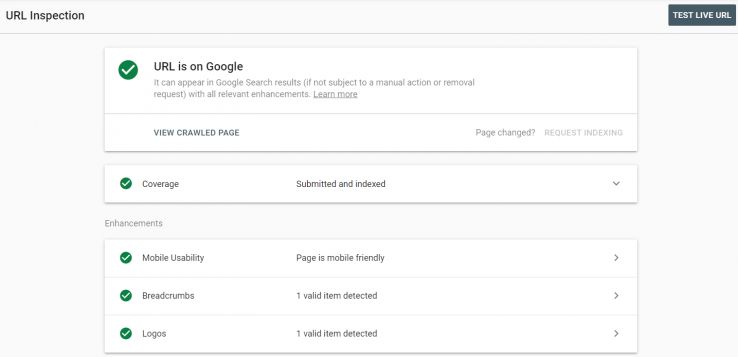
Pay particular attention to the Indexing section, where they mention user-declared canonical vs google-selected canonical. If the two differ, it’s definitely worth investigating the reason, as this means Google isn’t respecting the canonical directives placed on the page — check official resources to learn more about this.
Chrome extensions
I love Chrome extensions and I objectively have way too many on my browser…
Some Chrome extensions can give you lots of info on the indexability status of the page with a simple click, checking things like canonical tags and meta robots tags.
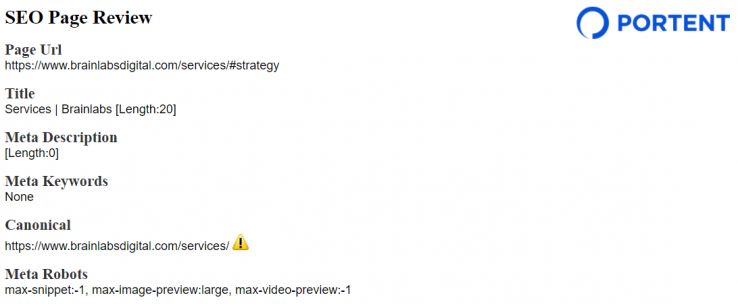
My favorite extensions for this matter are:
JavaScript check
I’ll keep it simple: JavaScript is key in today’s environment as it adds interactivity to a page. By doing so, it may alter some key HTML elements that are very important for SEO. You can easily check how a page would look without JS by using this convenient tool by Onley: WWJD.
Realistically speaking, you need only one of the following tools in order to check whether JavaScript might be a problem for your on-page SEO:
All the above tools are very useful for any type of troubleshooting as they are showcasing the rendered-DOM resources in real-time (different from what the “view-source” of a page looks like).
Once you’ve run the test, click to see the rendered HTML and try and do the following checks:
- Is the core part of my content visible?
- Quick way to do so: find a sentence in your content, use the search function or click CTRL + F with that sentence to see if it’s present in the rendered version of the page.
- Are internal links visible to Google?
- Quick way to do so: find an internal link on the page, use the search function or click CTRL + F with that sentence to see if it’s present in the rendered version of the page.
- Can Google access other key elements of the page?
- Check for things such as headers (example below with a Brainlabs article), products, pagination, reviews, comments, etc.
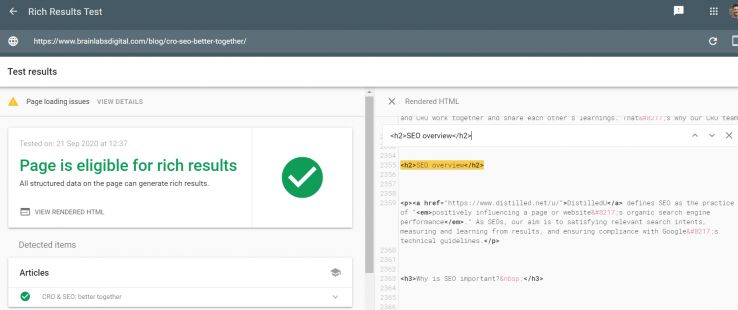
Intent and SERP analysis
By analyzing the SERP for key terms of focus, you’ll be able to identify a series of questions that relate to your content in relation to intent, competition, and relevance. All major SEO tools nowadays provide you with tons of great information about what the SERP looks like for whatever keyword you’re analyzing.
For the sake of our example, let’s use Ahrefs and the sample keyword below is “evergreen content”:
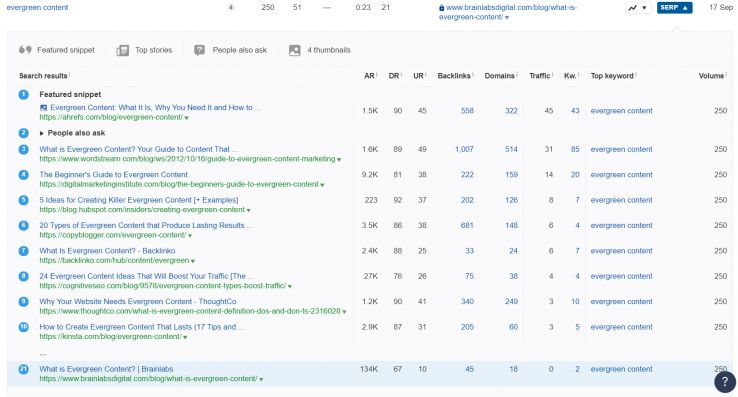
Based on this example, these are a few things I can notice:
- This keyword triggers a lot of interesting SERP features (Featured Snippet, Top Stories, People also ask)
- The top organic spots are owned by very established and authoritative sources (Ahrefs blog, Hubspot, Wordstream etc), which makes this keyword quite difficult to compete for
Here are quick suggestions on what types of checks I recommend:
- Understand and classify the keyword of analysis, based on the type of results Google is showing in the SERP: any ads showing, or organic snippets? Are the competing pages mainly transactional or informational?
- Check the quality of the sites that are ranking in page one: indicative metrics that can help you gather insights on the quality of each domain (DA/DR) are helpful, the number of keywords those pages are visible for, the estimated traffic per page, and so on.
- Do a quick crawl of these pages to bulk check the comprehensiveness of their content and metadata, or manually check some if you prefer that way.
By doing most of these checks, you’ll be able to see if your content is underperforming for any of the reasons previously mentioned:
- Content not compelling enough compared to what is ranking on page one
- Content in the wrong format compared to what Google is prioritizing
- Content is timely or seasonal
- Content is being overshadowed by SERP features
Duplication and cannibalization issues
Check out my 2019 post on this subject, which goes into a lot more detail. The quick version of the post is below.
Use compelling SEO tools to understand the following:
- whether, for tracked keywords of interest, two or more ranking URLs have been flip-flopping. That is a clear sign that search engines are confused and cannot “easily decide” on what URL to rank for a certain keyword.
- whether, for tracked keywords of interest, two or more ranking URLs are appearing at the same time (not necessarily on page one of the SERP). That is a clear signal of duplication/cannibalization.
- check your SEO visibility by landing page: if different URLs that rank for very similar keyword permutations, chances are there is a risk there.
- last but not least: do a simple site search for keywords of interest in order to get an initial idea of how many pages (that cover a certain topic) have been indexed by Google. This is an insightful preliminary exercise and also useful to validate your worries.
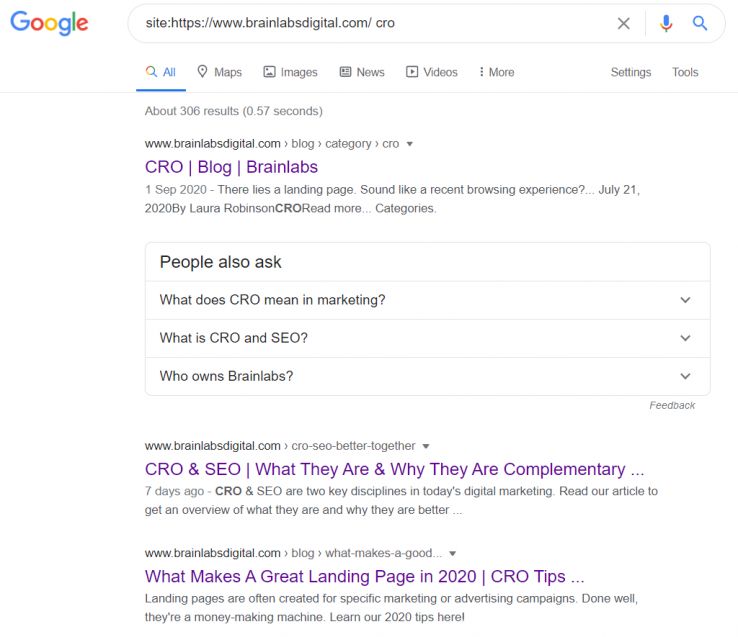
How to fix underperforming content
We’ve covered the most common cases of underperforming content and how to detect such issues — now let’s talk about ways to fix them.
Below is a list of suggested actions to take when improving your underperforming content, with some very valuable links to other resources (mostly from Moz or Google) that can help you expand on individual concepts.
Make sure your page can be crawled and indexed “properly”
- Ensure that your page does not fall under any path of blocked resources in Robots.txt
- Ensure your page is not provided with a no-index meta robots tag or a canonical tag pointing elsewhere (a self-referencing canonical tag is something you may want to consider but not compulsory at all).
- Check whether other pages have a canonical tag pointing to your URL of focus. Irrelevant or poorly-done canonical tags tend to get ignored by Google — you can check if that is the case in the URL Inspection tool.
- Ensure your site (not just your page) is free from any non-SEO friendly JavaScript that can alter key on-page elements (such as headers, body content, internal links, etc.).
- Ensure your page is linked internally on the site and present in your XML sitemap.
Understand search intent
- Search intent is a fascinating topic in and of itself, and there are a lot of great resources on the subject if you want to delve deeper into it.
- Put simply, you should always research what the SERP looks like for the topic of interest: by analyzing the SERP and all its features (organic and non), you can get a much better understanding of what search engines are looking for in order to match intent.
- By auditing the SERP, you should be able to answer the following questions:
- What type of content is Google favoring here: transactional, navigational, informational?
- How competitive are the keywords of focus and how authoritative are those competitors ranking highly for them?
- What content format is Google showcasing in the SERP?
- How comprehensive should my content be to get a chance to rank in page one?
- What keywords are used in the competitor’s metadata?
- What organic features should I consider addressing with my content (things like featured snippets, people also ask, top images, etc.)?
- Hopefully all the questions above will also give you a realistic view of your chances of ranking on Google’s first page. Don’t be afraid to switch your focus to PPC for some very competitive keywords where your real possibility of organic rankings are slim.
Map your pages against the right keywords
- This is a necessary step to make sure you have a clear understanding of not only what keywords you want to rank for, but also what keywords you are eligible to rank for.
- Don’t overdo it and be realistic about your ranking possibilities: mapping your page against several keywords variations, all of which show very different SERPs and intents, is not realistic.
- My suggestion is to pick two or three primary keyword variations and focus on getting your content as relevant as possible to those terms.
Write great metadata
- Title tags are still an incredibly important on-page ranking factor, so dedicate the right time when writing unique and keyword-rich titles.
- Meta descriptions are not a ranking factor anymore, but they still play a part in enticing the user to click on a search result. So from a CTR perspective, they still matter.
- SEO keyword research is the obvious choice to write compelling metadata, but don’t forget about PPC ad copies — check what PPC ad copies work best for your site and take learnings from them.
- Don’t change metadata too often, though: make sure you do your homework and give enough time to properly test new metadata, once implemented.
Make the right content amends
- Based on the intent audit and keyword mapping insights, you’re now ready to work on your actual page content.
- By now, you’ve done your homework, so you just need to focus on writing great content for the user (and not for Google).
- Readability is a very important part of a page. Tricks that I’ve learned from colleagues over the years are the following:
- Read the content out loud and try to objectively assess how interesting it is for your target audience.
- Make sure to use enough spacing between lines and paragraphs. People’s attention span these days is very short, and chances are people will skim through your content rather than dedicating 100% of their attention to it (I’m sure some of YOU readers are doing it right now!).
- Make sure your tone of voice and language match your target audience (if you can write things in plain English vs. highly technical jargon, do so and don’t over-complicate your life).
- Make sure you’ve thought about all internal linking possibilities across the site. Not only for the same type of page (transactional page to transactional page, for instance) but also across different types (transactional page to video/blog post, if that helps people make a decision, for example).
- Optional step: once everything is ready, request indexing of your page in Google Search Console with the URL inspection tool.
Final thoughts
Underperforming content is a very common issue and should not take you by surprise, especially considering that content is considered among (if not the) most important ranking factors in 2020. With the right tools and process in place, solving this issue is something everyone can learn: SEO is not black magic, the answer tends to be logical.
First, understand the cause(s) for your underperforming content. Once you’re certain you’re compliant with Google’s technical guidelines, move on to determining what intent you’re trying to satisfy. Your research on intent should be comprehensive: this is what’s going to decide what changes you’ll need to make to your content. At that point, you’ll be ready to make the necessary SEO and content changes to best match your findings.
